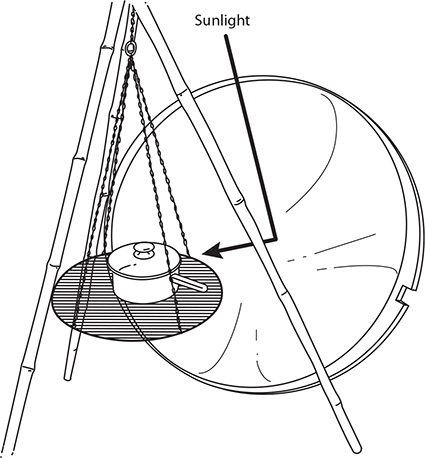
POP CAN ALCOHOL STOVE
You can make a very efficient little cooking stove in just a few minutes from 2 aluminum pop cans. Cut the lower third from both cans and pressure fit them together to make a closed container. Then, using a knife or spike, poke 6 holes around the top rim spaced equally apart and then also 2 or 3 in the middle of the bowl. Pour in an ounce or so of fuel and light with a match for an even, steady burn. The best fuels to use are available at nearly every grocery store, hardware store, or gas station. The 3 I’ve had success with are rubbing alcohol, denatured alcohol, and HEET brand gas-line antifreeze (yellow bottle). Once your stove is lit you’ll need to create a stand to suspend your cup or pot above the stove. A couple bricks work really well for this.
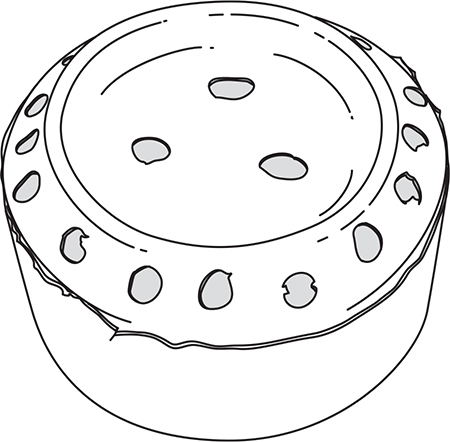
EGG CARTON BBQ
Starting charcoal briquettes can sometimes be a real challenge, and this little trick could make you the hero at your next family BBQ. Before heading out of the house, fill each space of an empty compressed paper (not Styrofoam) egg carton with a single charcoal briquette. About 15 minutes before you’re ready to grill, light the 4 corners of the paper egg carton and watch as the paper burns and ignites the charcoal briquettes. This gives you a chance to reuse something that you’d normally throw away and also not have to use that nasty lighter fluid to get the BBQ going. Bonus hack: Paper egg cartons also make 12 great individual biodegradable seed starters.
TOILET PAPER STOVE
The ingredients list for this hack is simple: a can about the size of a roll of toilet paper (a 1-quart paint can works great), a roll of toilet paper, and a bottle of rubbing alcohol (denatured alcohol and HEET brand gas-line antifreeze also work). To start, crush the roll of toilet paper and cram it into the can. Next, slowly pour the bottle of rubbing alcohol into the can and let it completely saturate the toilet paper. To use the stove, ignite the top of the toilet paper with a match or lighter and you’re ready to cook. When you notice the edges of the toilet paper are starting to burn, that means you are getting low on fuel. Snuff out the flame, add more alcohol, and relight. Note: If using indoors, be sure to crack a window because of carbon monoxide emissions.
TUNA CAN BURNER
Here’s a cool little hack to not only heat your meal but also make a hot drink. You’ll need a can of tuna packed in oil and a couple paper napkins. Remove the tuna lid and fold the napkins so they fit over the can opening with not much overlap except for the 4 corners. Give the oil a couple minutes to soak through the napkins. Once they are saturated with oil, light each corner on fire. The napkins will burn a surprisingly long time, creating a stove-like effect. The heat from the burning napkins will not only heat the tuna for a warm meal but can also be used to make a cup of hot tea in the process. Just build a couple supports on each side of the can to place a mug on and you’ll be all set!
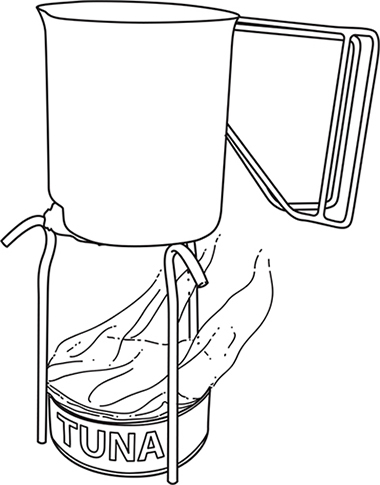
JUNK STOVE
You can make a very efficient little junk stove from an empty tuna can, some cardboard, and a variety of fuels. Cut 1" × 4" strips of cardboard and roll them into the empty can. Next, it’s time to add fuel. Pour melted wax on top of the cardboard and light it; you can also use any kind of cooking oil to saturate the cardboard. The cardboard acts as a wick, and I’ve had junk stoves like this burn for as long as 30 minutes. What I love about this stove design is that it can be made from so many different “junk” pieces. Tin cans and cardboard are available almost anywhere.
NEWSPAPER OVEN
Believe it or not, you can cook fish in wet newspaper. After cleaning and gutting the fish, wrap it in 4 or 5 sheets of wet newspaper and place right into the coals of a fire. The fish will cook and steam inside, but the wet newspaper will not fail. The outer layer may scorch a bit, but the water prevents it from burning. Fifteen minutes should be sufficient to cook most fish as long as it is completely surrounded by coals. You can use paper grocery bags in place of newspaper. If you find it necessary to fry food on a sheet of aluminum foil in the coals of a fire, place sheets of wet newspaper underneath to help control the heat and prevent burning.
INVERTED CAN OVEN
One of my favorite hacked survival ovens is made with just an inverted metal can. In fact, when I’m lucky enough to trap, hunt, or catch a bird in the wild I will always try to cook it this way if the materials are available. After plucking, gutting, and dressing the bird, skewer it on a stake that has been driven straight into the ground. Next, place a metal can or container over the top of the bird and stake so that it covers them completely. Build a fire around the metal can and gather hot coals around it. A good coal bed will be necessary to cook the bird in a timely manner (typically 1 hour). I have also cooked fish using the same method; skewer the fish head down on the stake. Some of my finest wilderness meals have been cooked with this method. This is a very energy-efficient cooking method, allowing you to work on other camp chores while dinner is cooking.
IMPROVISED SWEDISH TORCH
This is a great hack to make a small-footprint wilderness cooking stove using just 3 sections of log. First, cut 3 24"-long lengths of seasoned wood. The diameter of each should be at least 6". Next, use your axe or knife to make cuts and chips all up one side of each of these logs. This exposes the wood inside, and the resulting slivers will more easily catch fire. Arrange the logs standing up in a triangle so that the chipped areas are all facing inward toward each other. There should be less than 2" of space between them. Finally, fill the center cavity with fire tinder such as pine needles, twigs, bark, and leaves. Only minutes after this tinder is ignited, the logs themselves will begin to burn like a rocket stove. Place a skillet on top and cook as if you were in front of a range at home!
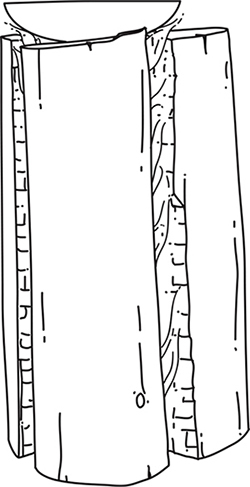
SHELF BRACKET STOVE
Being able to efficiently support or hang a cooking pot over a fire is sometimes easier said than done. One of my favorite quickie stove hacks involves 3 metal shelf brackets that cost under $5. They are also very lightweight and packable if you need to take them on the move. Once you’ve got a good bed of coals going, stab the metal L-shaped brackets into the ground as shown in the image and scoop the coals underneath. This makes for a very sturdy surface on which to cook stews, fry meats and wild veggies, or boil water. You can stab the short ends deeper in the ground to create a surface closer to the coals if necessary. Use 4 brackets to make a larger, square raised platform.
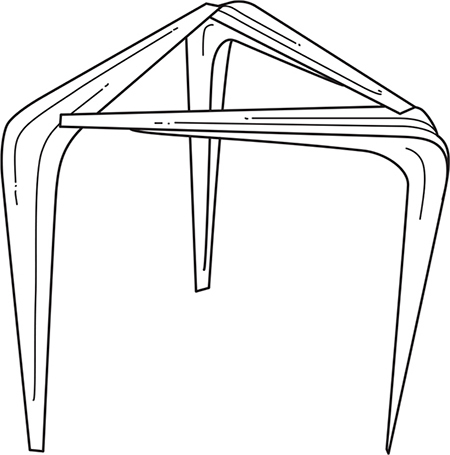
BRICK ROCKET STOVE
In a survival scenario you may need a stove for cooking that is both efficient (uses as little fuel as possible) and discreet (puts off little to no smoke). An improvised brick rocket stove is your answer to this need. To build one like that in the illustration you’ll need to use 1 half brick for both the first and second layer. Layers 3, 4, and 5 will each use 4 full-sized bricks. A thin metal grill should be placed between layers 1 and 2 to keep the sticks and twigs off the ground and allow for maximum airflow. Stoves of this design burn at almost 100 percent efficiency and have very little leftover ash or smoke. The design shown requires 20 bricks, 2 of them split in half.